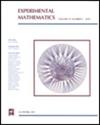解开结的硬图
IF 0.9
4区 数学
Q2 MATHEMATICS
引用次数: 1
摘要
我们提出解结的三个“硬”图。它们需要(至少)三个额外的交叉点,才能通过Reidemeister在$\mathbb{S}^2$中的移动简化为简单的解结图。这两个例子都是通过应用先前提出的方法构建的。它们的硬度证明使用了大量的计算资源。我们还确定,对于硬解结图的小“标准”示例,$\mathbb{S}^2$中的Reidemeister移动,不需要超过一次的额外交叉。本文章由计算机程序翻译,如有差异,请以英文原文为准。
Hard Diagrams of the Unknot
We present three"hard"diagrams of the unknot. They require (at least) three extra crossings before they can be simplified to the trivial unknot diagram via Reidemeister moves in $\mathbb{S}^2$. Both examples are constructed by applying previously proposed methods. The proof of their hardness uses significant computational resources. We also determine that no small"standard"example of a hard unknot diagram requires more than one extra crossing for Reidemeister moves in $\mathbb{S}^2$.
求助全文
通过发布文献求助,成功后即可免费获取论文全文。
去求助
来源期刊

Experimental Mathematics
数学-数学
CiteScore
1.70
自引率
0.00%
发文量
23
审稿时长
>12 weeks
期刊介绍:
Experimental Mathematics publishes original papers featuring formal results inspired by experimentation, conjectures suggested by experiments, and data supporting significant hypotheses.
Experiment has always been, and increasingly is, an important method of mathematical discovery. (Gauss declared that his way of arriving at mathematical truths was "through systematic experimentation.") Yet this tends to be concealed by the tradition of presenting only elegant, fully developed, and rigorous results.
Experimental Mathematics was founded in the belief that theory and experiment feed on each other, and that the mathematical community stands to benefit from a more complete exposure to the experimental process. The early sharing of insights increases the possibility that they will lead to theorems: An interesting conjecture is often formulated by a researcher who lacks the techniques to formalize a proof, while those who have the techniques at their fingertips have been looking elsewhere. Even when the person who had the initial insight goes on to find a proof, a discussion of the heuristic process can be of help, or at least of interest, to other researchers. There is value not only in the discovery itself, but also in the road that leads to it.
 求助内容:
求助内容: 应助结果提醒方式:
应助结果提醒方式:


